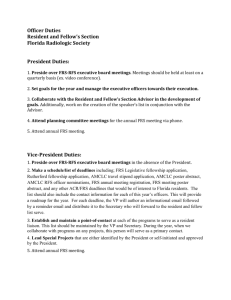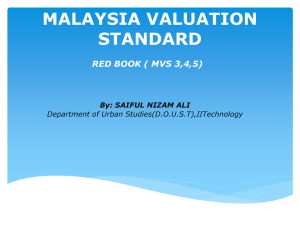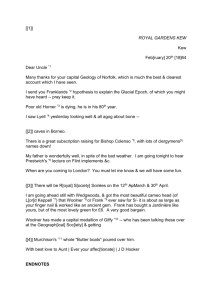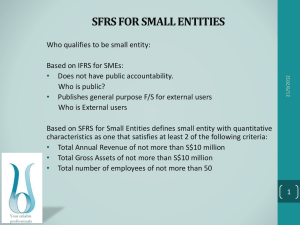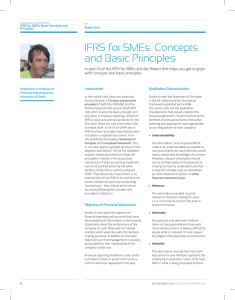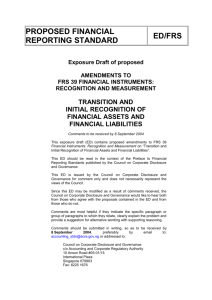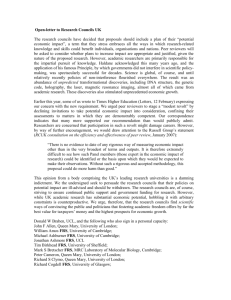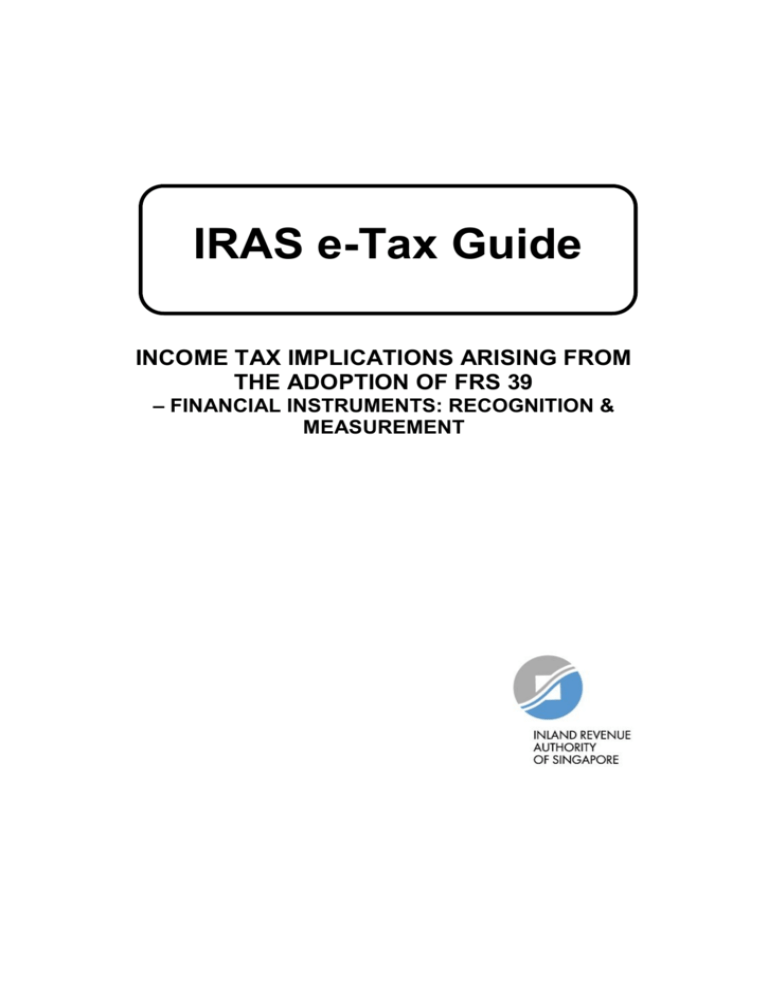
IRAS e-Tax Guide
INCOME TAX IMPLICATIONS ARISING FROM
THE ADOPTION OF FRS 39
– FINANCIAL INSTRUMENTS: RECOGNITION &
MEASUREMENT
Published by
Inland Revenue Authority of Singapore
Revised on 16 Mar 2015
First edition on 30 Dec 2005
Disclaimers: IRAS shall not be responsible or held accountable in any way for any
damage, loss or expense whatsoever, arising directly or indirectly from any
inaccuracy or incompleteness in the Contents of this e-Tax Guide, or errors or
omissions in the transmission of the Contents. IRAS shall not be responsible or held
accountable in any way for any decision made or action taken by you or any third
party in reliance upon the Contents in this e-Tax Guide. The information provided in
the guide aims to provide a better understanding of taxpayers’ tax obligations and is
not intended to comprehensively address all possible tax issues that may arise.
While every effort has been made to ensure that this information is consistent with
existing law and practice, should there be any changes, IRAS reserves the right to
vary our position accordingly.
© Inland Revenue Authority of Singapore
All rights reserved. No part of this publication may be reproduced or
transmitted in any form or by any means, including photocopying and
recording without the written permission of the copyright holder,
application for which should be addressed to the publisher. Such written
permission must also be obtained before any part of this publication is
stored in a retrieval system of any nature.
TABLE OF CONTENTS
PAGE
INTRODUCTION .......................................................................................................... 2
CURRENT TAX TREATMENT OF FINANCIAL ASSETS AND LIABILITIES.............. 2
CHANGES IN INCOME TAX TREATMENT ................................................................. 3
OPTION TO REMAIN IN PRE-FRS 39 TAX TREATMENT .......................................... 8
TAXPAYERS NOT REQUIRED TO COMPLY WITH FRS 39 ...................................... 9
ENQUIRIES .................................................................................................................. 9
UPDATES AND AMENDMENTS................................................................................ 10
ANNEX 1 .................................................................................................................... 11
ANNEX 2 .................................................................................................................... 13
IRAS e-Tax GUIDE
INTRODUCTION
1.
With effect from 1st January 2005, companies with annual periods beginning on
or after 1st January 2005 have to comply with Financial Reporting Standard 39 –
Financial Instruments: Recognition and Measurement (hereinafter referred to as “FRS
39”) for accounting purposes. This e-Tax Guide explains the changes to the treatment
of financial assets and liabilities for income tax purposes arising from the adoption of
FRS 39 1 for accounting purposes.
CURRENT TAX TREATMENT OF FINANCIAL ASSETS AND LIABILITIES
2.
Presently, for income tax purposes, only realised gains or losses arising from
the disposal of financial assets are subject to tax or allowed as a deduction if the
taxpayer derives such gains or incurs such losses on revenue account. As an
exception, where the financial assets on revenue account are carried at the lower of
cost and market value, and a provision for diminution in value has been made in the
accounts, the provision may be allowed as a deduction for income tax purposes while
any write-back up to the cost brought to tax.
3.
For a taxpayer whose gains or losses are derived on capital account, the gains
or losses are not taxable or allowed as a deduction. The provision for diminution in
value is also not allowed as a deduction.
4.
For banks and certain other entities that engage frequently in financial
derivatives for both hedging and trading purposes, we have, since 1996, granted an
administrative concession to accept the accounting treatment for financial derivatives
on the condition that they follow certain accounting treatment 2.
5.
For taxpayers with financial liabilities, such as loans taken or bonds issued, the
interest expense 3 incurred on such liabilities is allowed as a deduction by virtue of
section 14(1)(a) of the Income Tax Act (hereinafter referred to as “ITA”) when the
conditions in that section are met. In the case of financial liabilities that do not
constitute accretion to capital, any premium or discount incurred is taxed or allowed as
a deduction.
1
The version of FRS 39 referred to in this e-Tax Guide is the fourth version issued in August 2005. It
can be downloaded from the website of the Accounting Standards Council (which has taken over from
the Council on Corporate Disclosure and Governance (“CCDG”) the task of prescribing accounting
st
standards from 1 November 2007) - www.asc.gov.sg
2
(a) For financial derivatives for trading, they are accounted on a marked-to-market basis and the
resultant profit/losses are recognised immediately and taken to the profit and loss account.
(b) For financial derivatives used for hedging purposes, they must be clearly identified at the outset
and the gains or losses realised must be amortised over the life of the underlying hedged
transactions and matched with the gains/losses or income/expenditure of the latter transactions, in
all cases where there is a mismatch in the timing of the closing out of the two types of transactions.
The bank will maintain clear rules on how this matching is done.
3
This is based on the rate of interest in the contract.
2
CHANGES IN INCOME TAX TREATMENT
6.
With the adoption of the FRS 39 for accounting purposes, companies will now
have to reflect their financial assets and liabilities at market values in their financial
statements. A brief overview of the FRS 39 accounting treatment is provided in Annex
1. To minimise tax adjustments, the income tax treatment of financial assets and
liabilities has been changed so as to be closer generally to the accounting treatment
(this new tax treatment is hereinafter referred to as the “FRS 39 tax treatment”).
(A)
FINANCIAL ASSETS
Financial assets on revenue account
7.
For the financial assets on revenue account, the income tax treatment will be
aligned with that of the accounting treatment under FRS 39. This would mean that (a)
for the assets classified as fair value through profit or loss, all gains or losses
recognised in profit or loss (hereinafter referred to as the “profit and loss
account”) will be taxed or allowed as a deduction even though they are
unrealised;
(b)
for the assets classified as available-for-sale, all gains or losses which are
recognised in balance sheet (as a separate item in the equity) will not be taxed
or allowed as a deduction. At the time of derecognition 4, the cumulative gains or
losses recognised in equity that are transferred to the profit and loss account will
be taxed or allowed as a deduction. For these assets, impairment losses
(please also refer to paragraph 11), reversal amount of impairment losses5 and
foreign exchange gains or losses that are recognised in the profit and loss
account will be taxed or allowed as a deduction;
(c)
for the assets classified as held-to-maturity and loans, the “interest income”
based on the amount shown in the accounts, which is calculated using the
effective interest method 6 under FRS 39, will be taxed.
Arising from this alignment with the accounting treatment, taxpayers need not make
any adjustment for income tax purposes.
Financial assets on capital account
8.
In the event that the taxpayer claims that the financial assets are on capital
account, it should submit a list of these assets to the Comptroller of Income Tax
(hereinafter referred to as the “CIT”) for his determination whether they are indeed
assets on capital account. Where the CIT has agreed that they are assets on capital
account, the gains or losses will not be taxed or allowed as a deduction. This
4
Generally, this refers to the time when the assets are disposed of.
There is an exception for equity securities. The reversal amount of impairment losses for equity
securities are recognised in the balance sheet and only transferred to the profit or loss account when
they are derecognised.
6
Please refer to footnote 16 for an explanation of the effective interest method.
5
3
treatment will continue until such time that circumstances have changed and the
taxpayer requests for a review to treat the assets as being on revenue account, in
which case, the change of tax treatment will be prospective. However, the CIT
reserves the right to tax the gains that have been agreed to be on capital account if at
the time of realisation, there is evidence to show that the gains are revenue gains.
9.
For assets on capital accounts (except for debt securities and negotiable
certificates of deposit where the tax treatment is provided in paragraph 10 below),
gains or losses reflected in the profit and loss account, such as those arising from fair
valuing of the items or impairment losses, are to be adjusted since they are neither
taxable nor deductible for income tax purposes.
10.
For debt securities and negotiable certificates of deposit that are on capital
account, the interest income reflected in the profit and loss account under FRS 39 will
be adjusted to that based on the coupon/contractual rate 7 and that based on the
provisions of section 10(12) of the ITA respectively. In the case of discount /premium
derived from debt securities that are on capital account, adjustment will have to be
made to assess such discount/premium to tax upon maturity or redemption of the debt
securities in accordance with the provisions of section 10(8A).
Impairment of financial assets on revenue account
11.
Under FRS 39, impairment losses are incurred under certain circumstances
described in the Standard 8. General and specific provisions for bad and doubtful debts
would no longer be made. For income tax purposes, impairment losses incurred on
financial assets on revenue account will be allowed as a deduction and any reversal
amount will be taxed.
Special rules for impairment of financial assets on revenue account for banks and
finance companies in certain circumstances
12.
Under the Monetary Authority of Singapore (hereinafter referred to as the
“MAS”)’s Notice 612 9 “Credit Files, Grading and Provisioning”, any bank, merchant
bank or finance company which does not have a robust loss estimation process or
sufficient quality historical loan loss data and are unable to provide for collective
impairment under FRS 39 are required to continue to maintain a level of collective
impairment provisions that is not less than 1% of the gross loans and receivables after
deducting any individual impairment provisions that have been made.
As a
concession, subject to the conditions stipulated in section 14I of the ITA, the amount
determined under the provisions of section 14I will be deducted for income tax
purposes for a period of 5 years from the first year of assessment (hereinafter referred
to as the “YA”) that such bank, merchant bank or finance company is required to
comply with FRS 39 for accounting purposes. Such banks, merchant banks and
finance companies are expected to be able to comply with the requirements of FRS 39
for provision of impairment losses by the end of the fifth year. The tax concession to
claim the tax deductions referred to in this paragraph was extended in Budgets 2009,
7
This is because the interest income arrived at based on FRS 39 rule is based on effective interest
method that includes the transaction cost, discount and premium.
8
Paragraphs 58 to 62 of FRS 39
9
MAS Notice 1005 for merchant banks and MAS Notice 811 for finance companies
4
2012 and 2015. With the latest extension in Budget 2015, banks, merchant banks and
finance companies will be able to claim the tax deductions till YA 2019 or YA 2020,
depending on their financial year end; all other existing terms and conditions of the
scheme apply.
13.
For any annual period where the banks, merchant banks and finance companies
are able to provide for impairment losses under FRS 39, the entire impairment amount
for financial assets on revenue account computed under FRS 39 will be allowed.
Should there be any additional collective impairment amount required under MAS
Notice 6129 on prudence grounds, it will also be allowed as a deduction.
14.
Any reversal amount of the impairment losses previously allowed is taxable and
no indexation 10 of the reversal amount of impairment losses is required, including any
write-back of specific provision for doubtful debts made prior to FRS 39 tax treatment.
(B)
INTEREST–FREE & NON-ARM’S LENGTH LOANS
Interest-free loans
15.
For any interest-free loan, the “discount” of the loan recognised in the profit and
loss account will not be allowed as a deduction and the “interest income” recorded in
the profit and loss account will not be taxed because these are merely book entries.
This treatment is only applicable to genuine cases of interest-free loans where there is
no payment for these book entries. Hence, tax adjustments will be required to
disregard these items.
Non-arm’s length loans
16.
Under FRS 39, taxpayers are required to measure these loans at amortised cost
using the effective interest method. This means that at initial recognition of the loan,
there will also be a “discount” of the loan recognised in the profit and loss account. In
addition, apart from the interest received based on the contractual rate of say 2% when
the market interest rate is say 5%, there will also be “income” recognised over the life
of the loan which adds up to the “discount” written off to the profit and loss account at
the initial recognition.
17.
Notwithstanding the accounting treatment, only interest income based on the
contractual rate will be taxed. Hence, tax adjustments will be required to achieve this
outcome.
(C)
FINANCIAL LIABILITIES
18.
For the financial liabilities, the income tax treatment will also be aligned with that
of the accounting treatment under FRS 39, except for financial liabilities that constitute
accretion to capital or where the financial liabilities are in the form of convertible debt
securities. This would mean that 10
Indexation is the adjustment to compensate for the reduction of tax rate between the time the
deduction for doubtful debts was allowed to the time the same amount is brought back to tax.
5
(a)
for liabilities at fair value through profit or loss, all gains or losses will be taxed or
allowed as a deduction even though they are unrealised;
(b)
for liabilities measured at amortised cost using the effective interest method, the
interest expense computed under FRS 39 will be allowed as a deduction.
19.
For any borrowing that constitutes accretion to capital, tax adjustment is
required. Up to and including YA 2007, only interest expense incurred based on the
contractual rate is allowed under section 14(1)(a) of the ITA. With effect from YA 2008,
borrowing costs (other than interest expense) which are incurred as a substitute for
interest expense or to reduce interest cost, are also allowable under section 14(1)(a) 11.
Where such borrowing costs are in the form of a discount or premium on redemption of
debt securities (including the redemption of convertible debt securities), the deduction
under section 14(1)(a) is allowed only at the time the discount or premium is incurred
by the issuer (i.e. at maturity or redemption of debt securities), and the deduction is
given in respect of the difference between the redemption price and issue price of the
debt securities. The above tax treatment will also apply to an issuer that issues debt
securities that are convertible to another company’s shares (commonly known as
exchangeable debt securities).
20.
Under paragraphs 28 to 32 of FRS 32, an issuer of convertible debt securities
(which provide an option to the holder of debt securities to convert its debt securities to
the issuer’s own shares) is required to reflect the liability and equity components of
such debt securities separately on the issuer’s balance sheet. At initial recognition, the
issuer is required to fair value the liability component (as if there was no equity
component) and the equity component will be the difference between the fair value of
the convertible debt securities as a whole, and the fair value of the liability component.
Thereafter the issuer is required to amortise the discount/premium to the profit and loss
account, where the discount/premium is the difference between the redemption price
and the liability component initially recognised in the accounts. For income tax
purposes, the discount/premium attributable to the equity component or the embedded
derivative (which is the option to convert the debt securities into equity) is not allowable
as there is no actual cash outlay and such discount/premium is capital in nature
(being related to the issuer’s share capital). This is notwithstanding that the
discount/premium attributable to liability component is deductible under section 14(1).
Hence, tax adjustment will have to be made. For example, if an issuer issues
convertible bond at $100 that is redeemable at a premium of $10 and if such premium
is deductible under section 14(1), and assuming the fair value of the liability component
is $95, the equity component will in this example be $5. During the tenure of the
convertible bond, the difference between the redemption price of $110 and fair value of
liability component at initial recognition of $95, will be amortised to the profit and loss
account in accordance with FRS 39 . For income tax purpose, only the premium of $10
(being the premium on redemption) is allowable, while the premium attributable to
equity component of $5, will not be allowable as there is no outlay and the premium is
capital in nature.
11
st
For details, please refer to IRAS’ e-Tax Guide dated 21 June 2007 on “Tax deduction for borrowing
costs other than interest expenses”.
6
(D)
HEDGING INSTRUMENTS
21.
For hedging instruments where the underlying asset or liability is
on revenue account (e.g. trade receivables), unrealised gains will be taxed and
unrealised losses will be allowed as a deduction. However, for hedging instruments
where the underlying asset or liability is on capital account, unrealised gains or losses
will not be taxed or allowed as a deduction.
(E)
VALUATION
OF
ASSETS
IN
THE
COMPUTATION
OF
INTEREST
ADJUSTMENT
22.
Interest expenses and borrowing costs incurred in lieu of interest relating to
non-income producing assets are not deductible for income tax purposes. Interest
adjustments would have to be made in the tax computation if there are such expenses
applicable to non-income producing assets. Direct identification method can be
used if taxpayers can directly identify the interest-bearing funds used to acquire the
non-income producing assets. However, interest adjustments are normally made
using the total asset method (“TAM”). This method works on the principle that total
funds are used to finance total assets. Under the total asset method, interest
adjustment (disallowable interest expense) =
Cost
of
non-income
Cost of total assets
producing
assets
x
Interest expenses
23.
Before the introduction of FRS 39, historical cost is used for the numerator
and denominator of the TAM without taking into account any provisions made (e.g.
provision for depreciation and bad debts) and valuation surplus/deficit.
24.
With the adoption of the FRS 39 for accounting purposes, financial assets and
liabilities are now shown at fair value, cost or amortised cost. For tax purposes, the
treatment of financial instruments on revenue account is aligned with that of the
accounting treatment of FRS 39. In the computation of interest adjustment on nonincome producing assets, the value of these assets is the value reported in the
balance sheet without adjustment for any provisions made and valuation
surplus/deficit.
25.
However, taxpayers that wish to use historical cost to value the assets can
make an election in writing, at the time of submitting their tax return. They must be
able to track the historical cost of all the assets separately and keep proper records on
the cost of the assets. Once the election is made, it will be applied consistently.
Taxpayers can opt to use the value of the financial assets shown in the balance
sheet under the FRS 39 treatment at any time after that. Such a move to the FRS 39
valuation is irrevocable once it is exercised.
26.
If taxpayers have opted to remain on the pre-FRS 39 tax treatment described
in paragraph 30, the historical cost will be used to compute the value of the assets.
7
(F)
TRANSITIONAL RULES
27.
Under FRS 39, at the beginning of the financial year in which the Standard is
initially applied, the entity is required to identify those financial assets and liabilities that
shall be measured at fair value and those that shall be measured at amortised cost,
based on the criteria in FRS 39. It will then have to remeasure these items at fair value
or amortised cost as the case may be. Any difference between the remeasured
amount and the previous carrying amount, excluding available-for-sale assets, is
recognised as an adjustment to the balance of retained earnings at the beginning of
the financial year in which the Standard is initially applied (hereinafter referred to as the
“opening balance of retained earnings”). For available-for-sale assets, the difference
between the remeasured amount and the previous carrying amount together with
subsequent cumulative changes in fair value is recognised in a separate component of
equity until subsequent derecognition or impairment, when the entity transfers the
cumulative gain or loss to the profit and loss account.
28.
For financial assets and liabilities that are on revenue account, the adjustments
recognised in the opening balance of retained earnings will be taxed or allowed as a
deduction in the first YA that the FRS 39 tax treatment is applicable after the taxpayer
is required to adopt FRS 39 for accounting purposes 12 . For the available-for-sale
assets, as the gains or losses are recognised in equity, they will not be taxed or
allowed as a deduction in the said first YA.
29.
As a concession, a 5-year instalment plan will be granted for the additional tax
payable arising from the transitional tax adjustments for the first YA in which the FRS
39 tax treatment is applicable. To enjoy this concession, the taxpayer has to move to
FRS 39 tax treatment no later than the 5th YA after it has first adopted the FRS 39 for
accounting purposes.
OPTION TO REMAIN IN PRE-FRS 39 TAX TREATMENT
30.
The FRS 39 tax treatment described in the preceding paragraphs will be the
default tax treatment for all taxpayers that adopt FRS 39 for accounting purposes.
However, a taxpayer can elect in writing, at the time of submitting the tax return in
the first YA it adopts FRS 39 for accounting purposes to remain on the current tax
treatment described in paragraphs 2 to 5 (hereinafter referred to as “pre-FRS 39 tax
treatment”), with the option of moving to the FRS 39 tax treatment at any time
thereafter 13 . Such a move to the FRS 39 tax treatment is irrevocable once it is
exercised. A taxpayer that moves to the FRS 39 tax treatment at any time after the 5th
YA from the YA that it has first adopted FRS 39 for accounting purposes will not be
granted the 5-year instalment plan for the additional tax arising from the transitional tax
adjustments.
12
The transitional adjustments for income tax purposes also include the difference between the book
value of the financial assets or liabilities (i.e. the previous carrying amount) and the amount recognised
for income tax purposes as at the last day of the basis period of the year of assessment just before the
adoption of FRS 39 tax treatment. Examples are trade receivables, bond premium/discount, upfront fees
and deferred income.
13
Such taxpayers have to determine the transitional adjustments as at the first day of the annual period
in which the FRS 39 tax treatment is first applied.
8
Conditions for taxpayers that opt to remain in pre-FRS 39 tax treatment
31.
Taxpayers that opt to remain in the pre-FRS 39 tax treatment are required to
comply with the following two conditions:
a)
Furnish details showing how the tax adjustments are arrived at;
b)
Maintain relevant documents to support the tax adjustments made. This would
mean that the period of storage of such records may exceed the statutory
record-keeping period if the financial assets are not disposed of within this
period.
32.
If any taxpayer fails to comply with the above conditions, it will be required to
move to the FRS 39 tax treatment from the YA in which the failure to comply with the
conditions arises. Once the FRS 39 tax treatment is applied in any YA due to this
failure, the taxpayer will not be allowed to revert to the pre-FRS 39 tax treatment even
if it is able to comply with the two conditions subsequently.
TAXPAYERS NOT REQUIRED TO COMPLY WITH FRS 39
33.
For taxpayers that do not need to comply with FRS 39 for accounting purposes
or companies that are temporarily exempt by Accounting & Corporate Regulatory
Authority (“ACRA”) from complying with FRS 39 for accounting purposes, the pre-FRS
39 tax treatment continues to apply to them.
34.
A summary of FRS 39 tax treatment is in Annex 2.
ENQUIRIES
35.
For general enquiries or clarification on this e-Tax Guide, please call 18003568622.
9
UPDATES AND AMENDMENTS
Date of
amendment
Amendments made
1
6 Mar 2006
• Added footnote 11 at paragraph 21 (currently
footnote 13 at paragraph 28) on transitional
adjustments
2
14 Aug 2009
• Added paragraphs 19, 20, footnotes 10 and 20;
and
• Amended paragraphs 10, 18 and row 4(b) of
Annex 2
3
22 Mar 2010
• Added paragraphs 22 to 26 with subsequent
paragraphs consequentially re-numbered
4
29 Jun 2012
• Updated paragraph 12; and
• Amended row 2(b) of Annex 2
5
16 Mar 2015
• Updated paragraph 12; and
• Amended row 2(b) of Annex 2
10
ANNEX 1
Classifications of financial instruments
1.
All financial assets should be classified under the following four categories:
(a)
(b)
(c)
(d)
Financial assets at fair value through profit or loss;
Held for trading;
Designated as at fair value through profit or loss;
Available-for sale assets;
Held-to-maturity assets;
Loan and receivables.
2.
All financial liabilities should be classified under one of the following two
categories:
(a)
(b)
Financial liabilities at fair value through profit or loss;
Held for trading;
Designated as fair value through profit or loss;
Others, which will be measured at amortised cost.
Valuation of financial instruments
3.
All the financial instruments should be measured at fair value 14, except for:
(a)
loans and receivables, and held-to-maturity investments which should be
measured at amortised cost using effective interest method 15 ;
investment in equity instrument which do not have a quoted market price in an
active market and whose fair value cannot be reliably measured and derivatives
that are linked to and must be settled by delivery of such unquoted equity
instruments, which shall be measured at cost 16.
(b)
14
Fair value is defined in terms of a price agreed by a willing buyer and seller in an arm’s length
transaction. Where there is no active market, valuation techniques will be used. Factors influencing the
fair value of a financial instrument includes:
- time value of money
- credit risk
- foreign currency exchange prices
- commodity prices
- equity prices
- volatility
- prepayment risk and surrender risk
- servicing costs for a financial instrument
15
The effective interest method is a method of calculating the amortised cost of a financial asset or a
financial liability and of allocating the interest income or interest expense over the relevant period. The
effective interest rate is the rate that exactly discounts estimated future cash payments of receipts
through the expected life of the financial instruments. The calculation includes all fees and points paid or
received between parties to the contract that are an integral part of the effective interest rate, transaction
costs and all other premiums or discounts. [Extracted from paragraph 9 of FRS 39].
16
See paragraph 46 of FRS 39
11
Gains or losses
4.
The changes in the value of financial assets and liabilities at each year-end will
be dealt with under each category of the assets or liabilities17.
(a)
For financial assets and liabilities classified as at fair value through profit or loss
(category 1), the unrealised gains or losses are recognised in the profit and loss
account.
(b)
For available-for–sale financial assets (category 2), the unrealised gains and
losses are recognised directly in equity, through the statement of changes in
equity, except for impairment losses and foreign exchange gains or losses
which are recognised in the profit or loss account, until the financial asset is
derecognised, at which time the cumulative gain or loss previously recognised in
equity shall be recognised in the profit and loss account.
(c)
For financial assets (i.e. held-to-maturity assets, loans and receivables
(categories 3 and 4)) and financial liabilities carried at amortised cost, a gain or
loss is recognised in the profit and loss account when the financial asset or
financial liability is derecognised or impaired, or through the amortisation
process. The changes in the amortised cost calculated using the effective
interest method are recognised either as “interest income” 18 or “interest
expense” in the profit and loss account.
17
See paragraphs 55 and 56 of FRS 39
This is an accounting concept on interest income. It includes the interest based on the
coupon/contractual rate, amortised discount/premium and transaction cost of the debt instrument/loan.
18
12
ANNEX 2
Summary of FRS 39 Tax Treatment
No FRS 39 Accounting Treatment of Assets/Liabilities
FRS 39 Tax Treatment
Financial Assets - Subsequent measurement of
(a) Financial assets classified as “held for trading” & “designated at fair value through profit or loss (hereinafter referred to
as “P&L”)”
(b) Financial assets classified as “available-for-sale”
(c) Financial assets classified as “held-to-maturity”
(d) Financial assets classified as “loans & receivables”
1a
Fair value changes at each year-end for financial instruments For assets on revenue account, to adopt the accounting
classified as “held for trading” or “designated at fair value” are treatment and tax/allow the unrealized gains/losses.
recognised in P&L
For assets classified as “held-for-trading”, the presumption is
that the assets are on revenue account.
1b
Fair value changes at each year-end for “available-for-sale” For assets on revenue account, to adopt the accounting
assets are recognised in B/S (equity)
treatment where the unrealised gains/losses are recognized in
the B/S.
For assets on revenue account, to allow/tax the impairment
losses/reversal amount of the impairment losses. However,
for equity securities, the reversal amount of impairment losses
is taxed only until they are disposed of.
1c
1d
“Held-to-maturity” assets, loans and receivables to be measured
at amortised cost using the effective interest method. The
amortized amount, transaction cost and discount/premium
(using effective interest method) are reflected as “interest” in the
P&L at each year-end
For assets on revenue account, to adopt the accounting
treatment, i.e. to tax the interest income calculated using
effective interest method.
For assets on capital account, to tax interest income based on
contractual rate. Tax adjustments will be required.
No FRS 39 Accounting Treatment of Assets/Liabilities
FRS 39 Tax Treatment
2. Impairment of assets
a. For general taxpayers
b. For banks and finance companies in certain circumstances
2a
Impairment losses in respect of assets (such as loans and For assets on revenue account, to adopt the accounting
receivables), other than assets classified as fair valued through treatment, i.e. to allow a deduction for impairment losses and
P&L
to tax the reversal amount of impairment losses with no
indexation required.
2b
For banks, merchant banks and finance companies that are
unable to comply with the requirement of FRS 39 in the
provision of collective impairment losses in respect of assets on
revenue account and are required to provide for it under MAS
Notices 612, 1005 and 811 respectively.
3.
Loans are measured at amortised cost using the effective For interest-free loans, to disregard the “interest income” and
interest method and “interest income” is recognised in P&L.
“discount” as they are merely book entries (provided no
payment is involved).
To allow the provision for collective impairment losses under
the respective MAS Notices for a period of 5 years from the
first year the taxpayer adopts FRS 39 for accounting purposes.
The period was extended in Budgets 2009, 2012 and 2015.
With the latest extension in Budget 2015, banks, merchant
banks and finance companies will be able to claim the tax
After the 5-year period, the banks, merchant banks and finance deductions till YA 2019 or YA 2020, depending on their
companies are expected to comply with the impairment financial year end; all other existing terms and conditions of the
requirement under FRS 39. MAS may require further provision scheme apply.
despite full compliance with FRS 39 on prudence grounds.
To allow any further provision required under the respective
MAS Notices in addition to FRS 39 impairment losses.
3. Interest-free loans and Non-arm’s length loans
For non-arm’s length loans, interest income will be taxed and
interest expense will be allowed based on the contractual rate.
14
No FRS 39 Accounting Treatment of Assets/Liabilities
FRS 39 Tax Treatment
4. Financial liabilities - Subsequent measurement of
(a) Financial Liabilities classified at “fair value through P&L”
(b) Financial liabilities at amortised cost
4a
Unrealised gains/losses from the fair valuing of the liability To adopt the accounting treatment and tax/allow the unrealised
recognised in P&L
gains/losses.
For liabilities classified as “held-for-trading”, the presumption is
that the liabilities do not constitute accretion to capital.
4b
The amortized amount, transaction cost and discount/premium If the borrowing constitutes accretion to capital, only interest
(using effective interest method) are reflected as “interest” in the expense based on contractual rate, or effective from YA 2008,
P&L at each year-end
borrowing cost (other than interest expense) incurred as a
substitute for interest expense or to reduce interest cost, is
allowed.
If the borrowing does not constitute accretion to capital, to
adopt accounting treatment of allowing the interest expense
based on effective interest method.
In the case of convertible bonds which give the bond-holder an
option to convert his bonds into the issuing company's shares,
the discount/ premium attributable to the embedded derivative
(which is the option to convert the bonds into equity and is
known as the equity component) will not be allowed.
5. Hedging
5.
Unrealised gains or losses of derivatives that are used for To tax/allow the unrealised gains/losses if the underlying
hedging activities written off to P&L unless the derivatives meet assets or liabilities are on revenue account (e.g. trade
the conditions for hedge accounting.
receivables).
Not to tax/allow the unrealised gains/losses if the underlying
15
No FRS 39 Accounting Treatment of Assets/Liabilities
FRS 39 Tax Treatment
assets or liabilities are on capital account.
thus required.
Tax adjustment is
6. Transitional Rules
6
Unrealised gains/losses arising from transitional adjustments
- remeasure assets and liabilities at fair value or at amortised
cost according to the classification and any difference
between the remeasured amount and the previous carrying
amount is recognised as an adjustment of the balance of
retained earnings at the beginning of the financial year in
which FRS 39 is initially applied.
- for “available-for-sale” assets, any difference between the
remeasured amount and the previous carrying amount,
together with all subsequent cumulative changes in fair value
is recognised in a separate component of equity until
subsequent derecognition or impairment, where the
cumulative gain or loss is transferred to P&L
To adopt the accounting treatment and tax/allow amounts
recognised in the opening retained earnings.
By default, taxpayers are presumed to align the tax treatment
with the FRS 39 accounting treatment, unless they opt out.
They will be granted a 5-year instalment plan for additional tax
arising from the transitional adjustments.
A taxpayer can elect to stay on the pre-FRS 39 tax treatment
at the time it submits the tax return in the first YA it has
adopted FRS 39 for accounting purposes. It has the option of
moving on to the FRS 39 tax treatment irrevocably at a later
date. A concession of 5-year instalment plan granted if option
to move on to FRS 39 tax treatment is exercised no later than
the 5th YA after the taxpayer has first adopted FRS 39 for
accounting purposes.
7. Taxpayer not required to comply with FRS 39
7
19
Tax treatment of financial assets and liabilities for taxpayers that To allow pre-FRS 39 tax treatment.
are not required 19 to comply with FRS 39 for accounting
purposes
Such as sole-proprietors or partners of a partnership, or those that are temporarily exempted by ACRA from complying.
16


